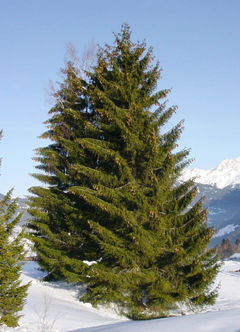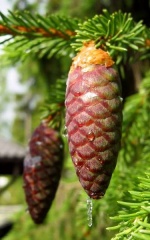Spruce
| Spruce |
|---|

|
| Scientific Classification |
|
| Species |
|
Thirty-five species of spruce are widely available in the United States of America. Many varieties are tall, conical to pyramidal trees (which is most known for being used for the Christmas tree). Spruce wood, often called whitewood, is used for many purposes, ranging from general construction work and crates to highly specialised uses in wooden aircraft and musical instruments and houses. It is also one of the most important woods for paper manufacturing, as it has long wood fibers which bind together to make strong paper.
Anatomy
Spruces are large trees, from 20-60 meters tall when fully mature, and can be distinguished by their whorled branches and conical form. The needles, or leaves, of spruce trees are attached singly to the branches in a spiral fashion, each needle on a small peg-like structure that is called a pulvinus. The needles are shed when they are 4-10 years old, leaving the branches rough with the retained pulvini.
Reproduction

The Spruce trees reproduce by seeding and by layering. Seed Production begins at 4 years of age but generally not in large amounts until 30 years of age or more. Good to excellent seed crops are produced every 2-6 years in good soils, but in many areas, only every 10-12 years, due to infertile soil.
Ecology
The spruce trees are very well know in the United States of America. They prefer wet areas with lots of rain. They are also well known in mountainous areas like Washington, Oregon, and Montana.
Gallery
Norway Spruce Picea abies
White Spruce Picea glauca
Blue Spruce Picea pungens



